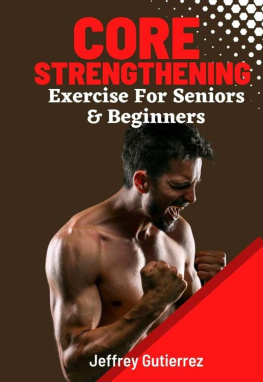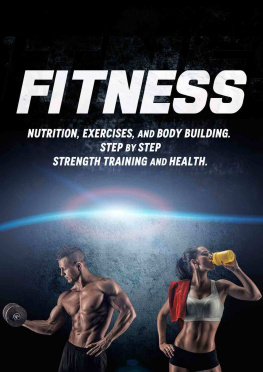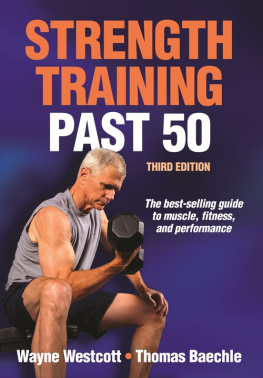Shirley Archer - The Strength and Toning Deck: 50 Exercises to Shape Your Body
Here you can read online Shirley Archer - The Strength and Toning Deck: 50 Exercises to Shape Your Body full text of the book (entire story) in english for free. Download pdf and epub, get meaning, cover and reviews about this ebook. year: 2011, publisher: Chronicle Books LLC, genre: Home and family. Description of the work, (preface) as well as reviews are available. Best literature library LitArk.com created for fans of good reading and offers a wide selection of genres:
Romance novel
Science fiction
Adventure
Detective
Science
History
Home and family
Prose
Art
Politics
Computer
Non-fiction
Religion
Business
Children
Humor
Choose a favorite category and find really read worthwhile books. Enjoy immersion in the world of imagination, feel the emotions of the characters or learn something new for yourself, make an fascinating discovery.

- Book:The Strength and Toning Deck: 50 Exercises to Shape Your Body
- Author:
- Publisher:Chronicle Books LLC
- Genre:
- Year:2011
- Rating:5 / 5
- Favourites:Add to favourites
- Your mark:
- 100
- 1
- 2
- 3
- 4
- 5
The Strength and Toning Deck: 50 Exercises to Shape Your Body: summary, description and annotation
We offer to read an annotation, description, summary or preface (depends on what the author of the book "The Strength and Toning Deck: 50 Exercises to Shape Your Body" wrote himself). If you haven't found the necessary information about the book — write in the comments, we will try to find it.
Strength training is one of the most effective ways to improve overall health and achieve a toned and fit appearance. Building strong, healthy muscles boosts your metabolism, increases your energy level, promotes good posture and balance, and helps prevent osteoporosis and injuries. With the 50 exercises in The Strength and Toning Deck, you can start right away with a basic conditioning program and progress your fitness training at your own pace.
The Strength and Toning Deck: 50 Exercises to Shape Your Body — read online for free the complete book (whole text) full work
Below is the text of the book, divided by pages. System saving the place of the last page read, allows you to conveniently read the book "The Strength and Toning Deck: 50 Exercises to Shape Your Body" online for free, without having to search again every time where you left off. Put a bookmark, and you can go to the page where you finished reading at any time.
Font size:
Interval:
Bookmark:
50 Exercises to Shape Your Body
By Shirley Archer
Strength training is one of the most effective ways to enhance the quality of your daily life: It makes you stronger and more energized, improves your overall health, and results in a toned and fit appearance. Having strong, healthy muscles boosts metabolism, increases bone density, helps prevent and eliminate back pain and injury, and contributes to better posture and balance. For most people, modern living does not provide enough physical challenges to keep muscles strong. We need the extra stimulation of a weight-training program to be at our best. With Strength and Toning: Reference to Go, you can start right away with a basic conditioning program and advance in difficulty as you grow stronger.
The American College of Sports Medicine recommends the following guidelines for beginning a muscular-strength-and-endurance training program:
- For each exercise, perform 1 set of 8 to 12 repetitions, or reps (healthy adults). Older (50-plus years), injured, or frail adults can use lighter weights for 1 set of 10 to 15 repetitions. Youth and teens, like older adults, can use lighter weights for 1 set of 13 to 15 repetitions, and should never train at maximum or near-maximum weight loads. Training for young people should be kept short and should be limited to two days a week.
- Perform 8 to 10 exercises per workout, covering all major muscle groups: arms, shoulders, chest, abdomen, back, hips, and legs.
- Train 2 to 3 days per week, taking a day off between workouts.
WARMING UP AND COOLING DOWN: Warming up and cooling down each time you train with weights will help prevent injuries. Always warm up for 5 to 8 minutes before you start any strength or toning exercises. Any rhythmic activity that uses the large muscle groups of the hips and legslike walking, jogging in place, jumping rope, or riding an exercise bicycleprovides an effective warm-up. The warm-up increases blood circulation to the muscles, stimulates smooth movement in the joints, and prepares the body and mind for physical effort.
The cool-down can consist of stretches for the targeted muscles performed at the end of each set, or can be a series of stretches performed at the conclusion of your workout. Either method prevents muscle soreness and enhances conditioning benefits. Stretching at the end of a workout will also increase your feeling of relaxation. Using good stretching techniques is essential: Hold each stretch to a point of moderate tensionwith no painin the target muscle(s). Ease off if you feel joint strain. Hold each stretch for 15 to 30 seconds. During inhalation, increase the stretch and release tension during exhalation. Avoid forced or rapid movements. As you stretch, release tension from other parts of your body, such as your shoulders, jaw, chest, and neck.
RESISTANCE METHOD AND EQUIPMENT: Muscles become stronger by overcoming resistance. This principle is referred to as overload. Many tools, even your own body weight, can provide the necessary overload. Occasionally changing the method of resistance stimulates muscles in different ways and forces them to adapt to new challenges. Such changes include using tubing instead of dumbbells or ankle weights and alternating the order of exercises within muscle groups. Tubing and bands are great training options because they are lightweight, easy to use, inexpensive, and easily transported.
Also, you will need a mat for ground exercises. For exercises that require a chair, use one that has a straight back and no arms and in which you can sit comfortably with your feet resting on the ground. When you exercise, wear comfortable, breathable clothing that allows you to move, and supportive athletic shoes. Stretches can be performed in bare feet or with shoes.
FREQUENCY OF WORKOUTS: For optimal conditioning results, train your total body 3 times a week. Between workouts, allow 48 hours of rest for muscles to recover and repair. Research shows that 75% of conditioning benefits come from a minimum of two workouts per week. Make a minimum commitment to train each of your major muscle groups two times a week to achieve and maintain physical improvements.
FINDING YOUR APPROPRIATE RESISTANCE LEVEL: If you can perform 15 reps of an exercise easily, the resistance is too light. Increase the weight so that the last couple reps feel difficult and the muscle is fatigued. Ideally, you should be able to perform 8 to 12 reps in about 50 to 70 seconds. This grouping of reps is referred to as a set. For older or frail adults, the ideal rep range is 10 to 15. For youth and teens, the recommended rep range is 13 to 15.
ORDER OF EXERCISES: Training your largest muscle groups before smaller ones will lead to optimal results. For example, muscles can be trained in the following order: hips and legs, chest and back, arms and shoulders, abdominals and back. Core training comes last because core stabilizers are necessary to stabilize your body during the workout.
WEIGHT-TRAINING TECHNIQUE: Proper technique is critical for injury prevention. Most important, you need to protect your joints. With every exercise, begin in neutral alignment. This position supports the natural curves of your spine and can be identified by imagining a plumb line through your body, with your ears above your shoulders, shoulders above hips, hips over knees, knees over ankles, and feet pointing forward. Tighten your abdominals to provide lower-back support. Since physical tension can inhibit smooth, efficient movement, consciously release tension throughout your body, especially in your shoulders.
When you use any handheld equipment, keep a solid yet relaxed grip. Avoid squeezing the weights, as doing so can elevate blood pressure. Tubing generally comes with handles and should also be held with a relaxed grip. For bands, you can secure the end between your thumb and index finger and make a fist. To increase hand comfort, wear padded weight-training gloves. Use slow, controlled, rhythmic movements. Proceed through a full range of motion with each rep and hold the exercise position for a moment at the peak muscular contraction to ensure that you are fully stimulating the targeted muscle fibers. Avoid swinging weights or using momentum. Feel each exercise in your working muscles. Be careful not to strain your joints. Always remember to breathe. Holding your breath can elevate blood pressure. If you find yourself holding your breath or breathing in short spurts, check your breathing periodically during the workout and cool-down to keep it steady and even.
REST INTERVALS: Between each set, you will want to rest briefly. The length of these rest periods will vary depending on your ultimate goal (fitness for health or fitness for improved athletic performance) and the intensity of the sets. Using heavier weights that lead to fatigue after fewer reps will require longer rest periods than using lighter weights with more reps. In general, your rest periods should last anywhere from 30 seconds to 3 minutes, depending on the intensity of your workout. You can use this time to stretch, or you can shorten rest periods for more effective time management by working on a different muscle group.
ADVANCING YOUR PROGRAM: When you first begin to train, you will need to condition your joints and connective tissues as well as tone up your muscles. To allow time for joint conditioning, wait at least 6 weeks before increasing the level of difficulty. After 6 weeks, you can add to your program by 1) increasing the number of sets (up to 3 sets) or 2) increasing the amount of weight (up to 5%). This weight increase should be to the point where you cannot perform more than 12 reps before your muscles are fatigued. Remember: Muscles require approximately 6 to 8 weeks to adapt to a new program.
Font size:
Interval:
Bookmark:
Similar books «The Strength and Toning Deck: 50 Exercises to Shape Your Body»
Look at similar books to The Strength and Toning Deck: 50 Exercises to Shape Your Body. We have selected literature similar in name and meaning in the hope of providing readers with more options to find new, interesting, not yet read works.
Discussion, reviews of the book The Strength and Toning Deck: 50 Exercises to Shape Your Body and just readers' own opinions. Leave your comments, write what you think about the work, its meaning or the main characters. Specify what exactly you liked and what you didn't like, and why you think so.





![Cotter - Kettlebell training: [95 exercises for strength, toning, stamina, and weight loss]](/uploads/posts/book/196732/thumbs/cotter-kettlebell-training-95-exercises-for.jpg)
